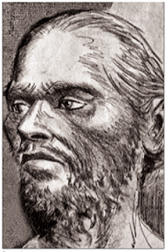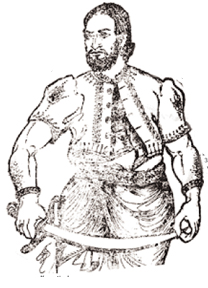Peace after violence mars post - 1948
Wijitha NAKKAWITA
|

Puran Appu
|
Today we celebrate the 62nd anniversary
of Independence after regaining our freedom from the British colonial
rule for 133 years. Yet this year's independence day is more meaningful
as it is the first such occasion celebrated in the country that was
liberated from terrorism after three decades.
When we regained independence in 1948 some people, even leaders wrote
that it was achieved without shedding a single drop of blood. It meant
in other words that the British had granted independence out of sheer
consideration of the goodness of our leaders.
The truth of course is very far from it. In just two years after the
Kandyan chiefs handed over the last Sinhala Kingdom ruled by Sri
Wickrama Rajasinghe the people of the Kandyan region rose in rebellion
against the British. They fought the British Red Coats for the next
three years and many Kandyan chiefs, officials, laymen and clergy joined
it. It was at its height in the Uva-Wellassa region but later several
other regions like Dumbara, Matale, Hewaheta and Sabaragamuwa joined in
the uprising.
The famous Kandyan chief Moneravila Keppetipola Dissawa who served
the British as one of the high local officials also joined the rebellion
and became its leader. The British Governor Robert Brownrigg called for
reinforcements to his army from India when the rebellion became more
widespread.
Next he gave that infamous scorched earth order to cut down all fruit
trees, burn down all houses, destroy all irrigation systems and rice
paddy and kill each Sinhala male over 14 years of age. About 40,000
native people were killed while the British Red coats lost 2000 men and
40 officers. Keppetipola Dissawa was caught and beheaded.
After the rebellion was quelled the breadbasket UVA Wellassa Province
became a depopulated and starving region. But before that Robert
Brownrigg wrote to the Colonial Secretary, Lord Bathurst that the
province was so rich in its food crops he could even export its crops to
India.
Then came the notorious land grab of the Kandyan peasantry by the
British under the two draconian laws, the Crown Lands Ordinance and
Waste Lands Ordinance. Nearly 1.3 million acres of land was confiscated
by the Government from the people and were sold to British planters to
open up coffee plantations. A second rebellion of the people took place
in the Kandyan region at Matale. Later the people of the north western
region joined it. It was led by a Buddhist monk Kadahapola Unnanse but
later Francis Fernando a brave young man of Moratuwa and Don David
another young man of Peliyagoda joined the rebellion and were its
leaders. Francis was renamed Puran Appu and David was renamed
Gongalegoda Banda and were acknowledged king and viceroy. That rebellion
too failed before the fire power of the British troops. The rebellion's
leaders were executed.
|

Keppetipola |
When the sentence to execute Puran Appu was passed by a military
court Puran Appu was recorded to have told the judges, that if his
mother had given birth to two more sons like him, the British would have
been chased out of Sri Lanka.
Though we regained independence in 1948 this country's laws were
implemented under the name of the King or Queen of England. The courts
heard cases in the name of the queen . The Supreme Courts was not the
final judicial authority as the citizens had the right to appeal to the
Privy Council against a judgment of the Supreme Court.
It was only after the Republican Constitution of 1972 that we became
a truly independent nation severing all connections with the British
Crown.
However a new threat of terrorism started emerging following the 1972
constitution but as a group of misled youth who were egged on by some
politicians of the north. Gradually the group split into several groups
until the strongest among them the LTTE suppressed the other groups by
killing most of the other leaders and cadres.
Government after Government attempted to militarily defeat them and
also pursued the path of peace talks but the LTTE sidetracked each
session of peace talks stalling for time but strengthening its armory
and its cadres in the interim periods of ceasefires. Not until 2002 that
a government of Sri Lanka conceded a separate area of control for the
terrorist group and it became apparent that the terrorists had become
very strong nationally and internationally.
Then in 2005 came the Presidential election when Mahinda Rajapaksa
was elected the fifth Executive President. Of all our leaders he was
aware that the LTTE would not honour any agreement on paper and would go
back on it for their advantage. The rest is now history. The leadership
of President Rajapaksa was the main factor that led to the defeat of the
terrorists as he did not bow before national and international pressures
to stop the military offensive against the terrorists. Therefore when we
celebrate independence today we are doing so in an undivided country and
for the first time the people of this country are free to travel to any
part for the first time in 30 years without fear. |

